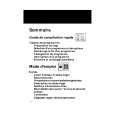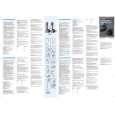No hay comentarios de productos.
Operation Guide 2836
Important! � Storing the watch for long periods in an area where there is no light or wearing it in such a way that it is blocked from exposure to light can cause rechargeable battery power to run down. Be sure that the watch is normally exposed to bright light whenever possible. � This watch employs a solar cell that converts light into electricity, which charges a built-in rechargeable battery. Normally, the rechargeable battery should not need replacement, but after very long use over a number of years, the rechargeable battery may lose its ability to achieve a full charge. Should you notice problems with getting the rechargeable battery to a full charge, contact your dealer or CASIO distributor about having the rechargeable battery replaced. � The rechargeable battery should be replaced with a CASIO-specified CTL1616 battery only. Other rechargeable batteries can cause damage to the watch. � All data stored in memory is deleted, and the current time and all other settings return to their initial factory defaults whenever battery power drops to Level 4 and when you have the battery replaced. � Turn on the watch�s Power Saving function and keep it in an area normally exposed to bright light when storing it for long periods. This helps to keep the rechargeable battery from going dead.
|
| |
� The above exposure time values are all for reference only. Actual required exposure times depend on lighting conditions.
Reference
This section contains more detailed and technical information about watch operation. It also contains important precautions and notes about the various features and functions of this watch.
Power Saving Function
When turned on, the Power Saving function automatically puts the watch into a sleep state whenever it is left in an area where it is dark for 30 to 35 minutes. The sleep state is indicated by a blank screen with SLEEP flashing on it. In the sleep state, all functions are enabled, except for the display. � Wearing watch inside the sleeve of clothing can cause it to enter the sleep state.
Battery Power Indicator and Recover Indicator (RECOV)
The battery power indicator on the display shows you the current status of the rechargeable battery�s power.
�
Level 1 2 3
Battery power indicator
Battery Power Indicator
Function Status All functions enabled. All functions enabled. Beeper tone, backlight, display, and buttons are disabled.
To recover from the sleep state Perform any one of the following operations. � Move the watch to a well-lit area. It can take up to five seconds for the display to turn on. � Press any button. � Angle the watch towards your face for reading. To turn Power Saving on and off 1. In the Timekeeping Mode, hold down A until the seconds start to flash, which indicates the setting |||| screen. 2. Press C seven times until the Power Saving on/off screen appears. 3. Press D to toggle Power Saving on (ON) and off (OFF). 4. Press A twice to exit the setting screen. � The Power Saving on indicator (SAVE) is on the display in all modes while the Power Saving is turned on.
�
�
|| |||
||||||
|
(Charge Soon Alert)
4
All functions, including timekeeping, are disabled.
� The flashing indicator at Level 3 tells you that battery power is very low, and that exposure to bright light for charging is required as soon as possible. � At Level 4, all functions are disabled and settings return to their initial factory defaults. Functions are enabled once again after the rechargeable battery is charged, but you need to set the current time, date, and all other settings after the battery is recharged to Level 2 from Level 4. Though the time appears on the display after the battery is charged to Level 3, you will not be able to change the time setting until the battery reaches Level 2. � Leaving the watch in direct sunlight or some other very strong light source can cause the battery power indicator to temporarily show a reading that is higher than the actual battery level. The correct battery power indicator should appear after a few minutes. � If you use the backlight or any of the alarm functions a number of times during a short period, RECOV appears on the display and the following operations become disabled until battery power recovers. Backlight Beeper tone After some time, battery power will recover and RECOV will disappear, indicating that the above functions are enabled again.
Moon Phase Indicator
The Moon phase indicator of this watch indicates the current phase of the Moon as shown below.
| |
|
Moon Phase Indicator Moon Age Moon Phase 0, 1, 29 New Moon 2-5 6-9 First Quarter (Waxing) 10 - 13 14 - 16 17 - 20 21 - 24 25 - 28 Full Moon Last Quarter (Waning)
� The Moon phase indicator shows the Moon as viewed at noon from a position in the Northern Hemisphere looking south. Note that at times the image shown by the Moon phase indicator may differ from that of the actual Moon in your area. � The left-right orientation of the Moon phase is reversed when viewing from the Southern Hemisphere or from a point near the equator. Moon Phases and Moon Age The Moon goes through a regular 29.53-day cycle during which it appears to wax and wane due to how the Sun illuminates the Moon and the relative positioning of the Earth, Moon, and Sun. The greater the angular distance between the Moon and the Sun,* the more we see illuminated. * The angle to the Moon in relation to the direction at which the Sun is visible from the Earth. This watch perform a rough calculation of the current Moon age starting from day 0 of the moon age cycle. The actual Moon age average cycle is 29.53 days, but this can vary anywhere from �1 day to +1 day for specific months. Since this performs calculations using integer values only (no fractions), the margin for error of the displayed Moon age is ±2 days.
Charging Precautions
Certain charging conditions can cause the watch to become very hot. Avoid leaving the watch in the areas described below whenever charging its rechargeable battery. Also note that allowing the watch to become very hot can cause its liquid crystal display to black out. The appearance of the LCD should become normal again when the watch returns to a lower temperature. Warning! Leaving the watch in bright light to charge its rechargeable battery can cause it to become quite hot. Take care when handling the watch to avoid burn injury. The watch can become particularly hot when exposed to the following conditions for long periods. � On the dashboard of a car parked in direct sunlight � Too close to an incandescent lamp � Under direct sunlight
Tide Graph
The black bar on the watch�s tide graph indicates the current tide.
Charging Guide
After a full charge, timekeeping remains enabled for up to about 11 months. � The following table shows the amount of time the watch needs to be exposed to light each day in order to generate enough power for normal daily operations. Exposure Level (Brightness) Outdoor Sunlight (50,000 lux) Sunlight Through a Window (10,000 lux) Daylight Through a Window on a Cloudy Day (5,000 lux) Indoor Fluorescent Lighting (500 lux) Approximate Exposure Time 5 minutes 24 minutes 48 minutes 8 hours
Tidal Movements Tides are the periodic rise and fall of the water of oceans, seas, bays, and other bodies of water caused mainly by the gravitational interactions between the Earth, Moon and Sun. Tides rise and fall about every six hours. The tide graph of this watch indicates tidal movement based on the Moon�s transit over a meridian and the lunitidal interval. The lunitidal interval differs according to your current location, so you must specify a lunitidal interval in order to obtain the correct tide graph readings. Lunitidal Interval Theoretically, high tide is at the Moon�s transit over the meridian and low tide is about six hours later. Actual high tide occurs somewhat later, due to factors such as viscosity, friction, and underwater topography. Both the time differential between the Moon�s transit over the meridian until high tide and the time differential between the Moon�s transit over the meridian until low tide are known as the �lunitidal interval.� When setting the lunitidal interval for this watch, use the time differential between the Moon�s transit over the meridian until high tide.
� Since these are the specs, we can include all the technical details. � Watch is not exposed to light � Internal timekeeping � Display on 18 hours per day, sleep state 6 hours per day � 1 backlight operation (1.5 seconds) per day � 10 seconds of alarm operation per day � 1 countdown timer operation per day � Stable operation is promoted by frequent charging. Recovery Times The table below shows the amount exposure that is required to take the battery from one level to the next. Exposure Level (Brightness) Approximate Exposure Time Level 4 Level 3 2 hours 7 hours 12 hours 140 hours Level 2 29 hours 144 hours 293 hours Level 1 8 hours 40 hours 81 hours
Auto Return Feature
If you leave a screen with flashing digits on the display for two or three minutes without performing any operation, the watch automatically saves any settings you have made up to that point and exits the setting screen.
Outdoor Sunlight (50,000 lux) Sunlight Through a Window (10,000 lux) Daylight Through a Window on a Cloudy Day (5,000 lux) Indoor Fluorescent Lighting (500 lux)
Scrolling
The B and D buttons are used in various modes and setting screens to scroll through data on the display. In most cases, holding down these buttons during a scroll operation scrolls through the data at high speed.
���
||||
(part you cannot see)
Moon phase (part you can see)
High tide
Low tide
4





